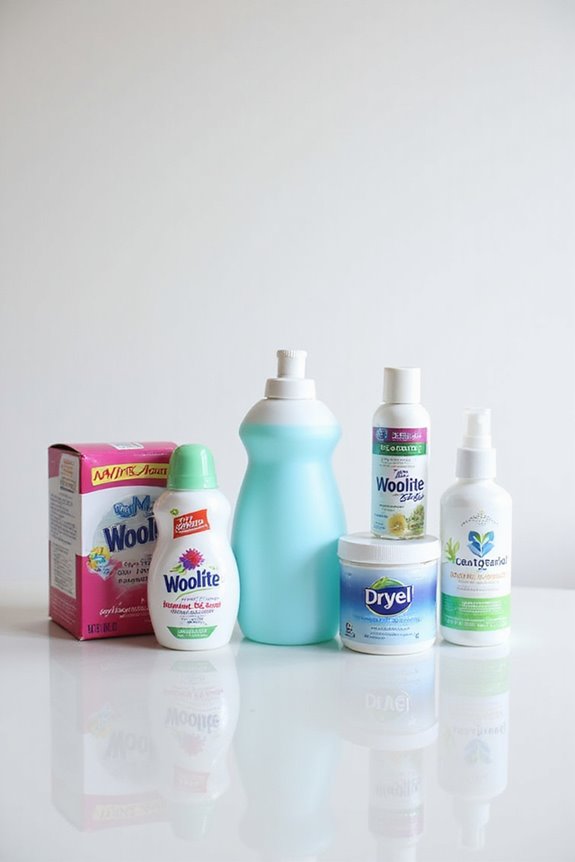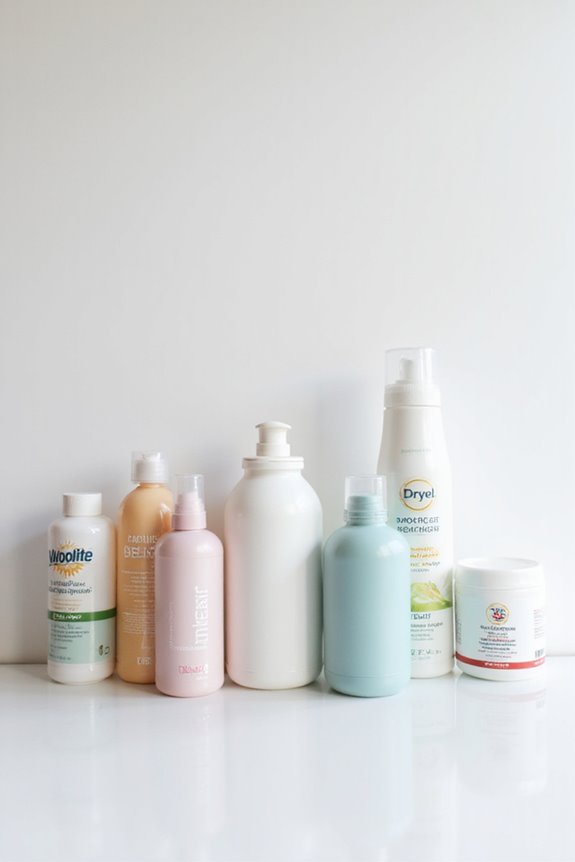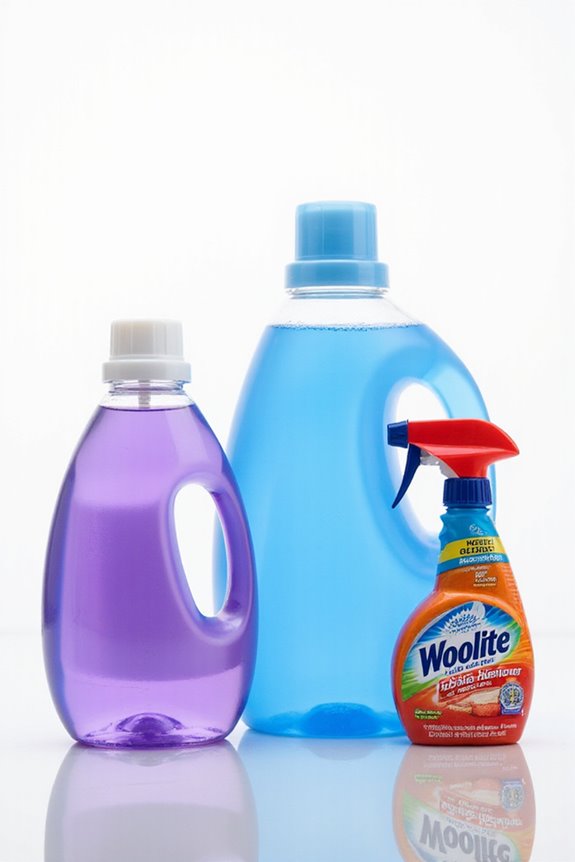We wouldn’t recommend mixing laundry detergent and fabric softener together. They use different types of surfactants that can react poorly, reducing their effectiveness. It’s best to add fabric softener during the rinse cycle, not the wash, to avoid residue buildup. Trust us, your clothes will thank you for following this simple rule! Plus, there are plenty of alternatives out there that work wonders without the risk. Stick around, and we’ll share some of those tips shortly!
Key Takeaways
- Mixing laundry detergent and fabric softener can create chemical reactions that reduce effectiveness and may lead to residue buildup on clothes.
- Fabric softener should only be added during the rinse cycle to achieve optimal softening effects and prevent it from being washed away.
- Using both products together can trigger skin allergies and irritations due to harsh chemicals in softeners.
- Keeping detergent and softener separate helps maintain cleaner laundry and prevents gunk buildup in washing machines.
- Consider eco-friendly alternatives like vinegar or wool dryer balls for softening without the risks associated with traditional fabric softeners.
Understanding the Chemical Incompatibility
When we think about doing laundry, we usually want our clothes to come out clean and fresh. But did you know that mixing laundry detergent and fabric softener can lead to some serious chemical incompatibility? These products contain different surfactants with opposite charges. Detergents typically use anionic surfactants, while softeners use cationic ones. When they interact, they can form insoluble compounds, which means they don’t work well together. This can hurt our laundry’s cleanliness and softness. Plus, we might even find some of these residues sticking to our clothes. It’s a bit like trying to mix oil and water—things just don’t blend! So, let’s keep our cleaning and softening routines separate for the best results. Additionally, using detergents with effective stain removal properties can enhance the overall cleanliness of your laundry.
The Importance of Proper Usage Timing

To get the most out of our laundry routine, we need to pay attention to when we add fabric softener. Proper fabric softener timing is essential; it should always go in during the rinse cycle. If we add it too early, the detergent washes it away, and we miss out on that softening magic. Plus, the rinse cycle effects really help distribute the softener evenly across our clothes. Agitation during this cycle guarantees every fiber gets that nice coating, reducing the risk of sticky residue. So, whether we’re using a front-load or top-load washer, let’s make certain we follow the timing. Our clothes will feel softer, smell fresher, and we’ll avoid those annoying patches of concentrated softener! Additionally, using a fabric softener with eco-friendly ingredients can enhance the overall laundry experience while being gentle on the environment.
How Mixing Affects Cleaning and Softening
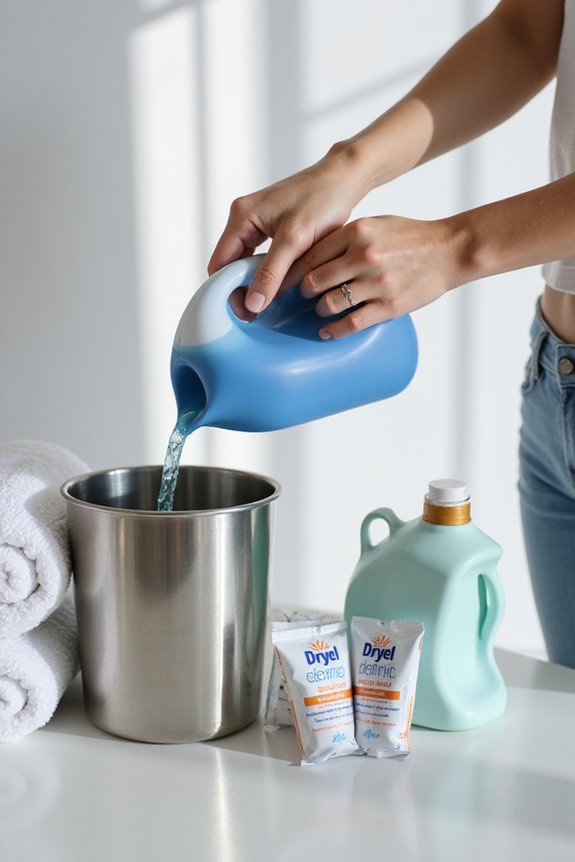
Mixing laundry detergent and fabric softener might seem like a time-saver, but it can lead to some messy outcomes. When we mix these products, we risk creating chemical reactions that produce insoluble groups, reducing both cleaning efficiency and softening effectiveness. Detergents work hard during the wash cycle, while fabric softeners shine in the rinse cycle. If we add softener too early, it can end up washed away, causing residue buildup on our clothes and machines. Plus, some softeners can increase flammability concerns, which isn’t ideal. To keep our laundry routine effective, we should stick to using these products separately. After all, who wants gunk in their washer or a less-than-fresh load of laundry? Additionally, using hypoallergenic formulas can help minimize skin irritation for individuals with sensitive skin when choosing laundry products.
The Role of Separate Compartments in Washing Machines
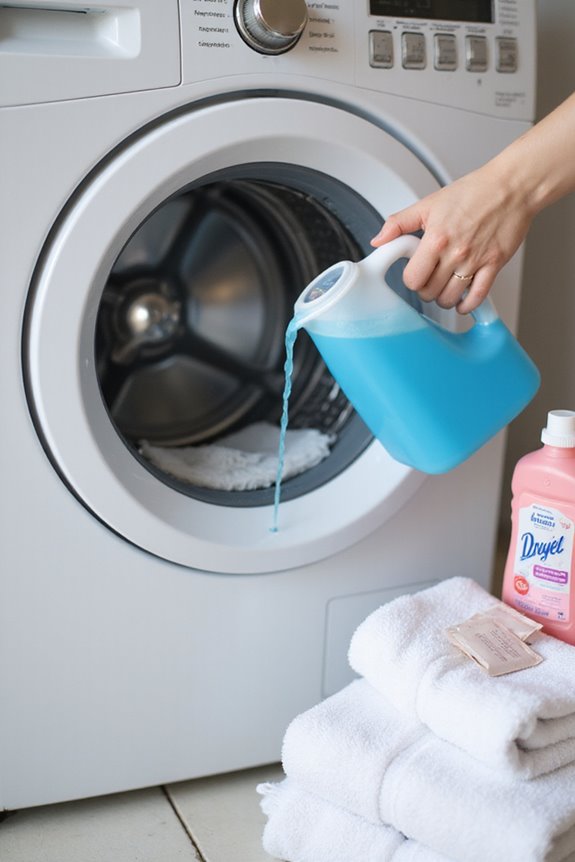
Using separate compartments in washing machines really helps us get the best results from our laundry routine. We typically have three compartments: one for prewash, one for the main wash, and one for fabric softener. Compartment identification is key here; look for symbols like “I” for prewash and a flower icon for softener. Each compartment has specific functionality—detergents go in the main wash, while fabric softener gets released during the rinse cycle. This separation prevents the products from mixing too early, guaranteeing our clothes get cleaned effectively without damage. Additionally, using fabric softeners effectively can reduce static cling and ensure our laundry smells fresh—who doesn’t want that?
Exploring 2-in-1 Detergent and Fabric Softener Products
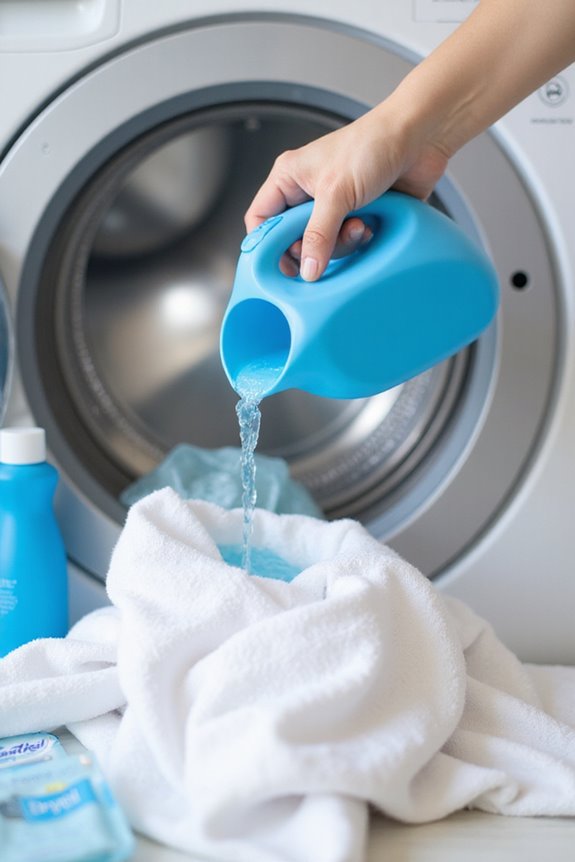
Have you ever wondered how laundry could be both clean and soft in one simple step? With 2-in-1 detergent and fabric softener products, we get to enjoy incredible 2-in-1 benefits. These gems combine cleaning efficiency with fabric care, making laundry day a breeze. They often feature eco-friendly options, using plant-based ingredients that appeal to our green thumbs. Plus, market trends show a rise in these products, aligning with consumer preferences for convenience. Innovations like Tide Plus A Touch of Downy give us scent longevity while protecting our clothes. While we might not get the same softening effect as dedicated softeners, the usage convenience can be hard to beat. Additionally, many of these products use biodegradable ingredients to ensure a safer wash for both our clothes and the environment. So why not give these products a try? You might just love them!
Practical Recommendations for Your Laundry Routine
When it comes to laundry, we all want to get the best results without complicating the process. To make our laundry routine effective, let’s follow some simple laundry tips. First, always use detergent first for a deep clean. Then, add fabric softener during the rinse cycle for ideal fabric care. Remember, fabric softeners aren’t for towels or water-repellent fabrics. Instead, they shine on everyday clothes and synthetics that cling. We should also stick to the recommended amounts to avoid residue. If you have sensitive skin, consider using hypoallergenic options. Additionally, using plant-derived ingredients can enhance your laundry’s eco-friendliness. By following these steps, we can enjoy soft, fresh-smelling clothes without any laundry drama. Let’s tackle those laundry days like pros!
Potential Risks of Mixing Products
Although mixing laundry detergent and fabric softener might seem like a good way to get clean, fresh-smelling clothes, it can actually lead to some serious risks. For starters, fabric softener risks include triggering asthma and skin allergies due to harsh chemicals. We might even experience itchy skin or rashes after wearing treated clothes. Plus, combining these products can create residues that build up in our washing machines, affecting laundry safety and performance over time. Let’s not forget about air quality; those fragrant chemicals can contribute to indoor pollution, making our homes less inviting. So, as tempting as it is to double up on products, we should think twice and stick to one for a safer laundry day!
Signs of Improper Use in Laundry
How can we tell if we’re using our laundry products incorrectly? One sign is excessive suds in the washer, leaving behind visible residue on our clothes. If our garments feel stiff or scratchy, we might be dealing with fabric softener buildup or insufficient detergent. Unpleasant odors can also hint that we’re trapping moisture in detergent residue. We’ve probably all experienced the frustration of rewashing clothes that still look dirty, which could mean we didn’t use enough detergent. If our washing machine starts acting up, like making strange noises, it could be due to chemical reactions from product buildup. Ignoring these signs can lead to fabric damage and costly washing machine malfunctions, so let’s keep an eye out!
Benefits of Using Products as Intended
Using laundry products as intended can make a world of difference in our washing routine. When we use fabric softener correctly, we boost its product effectiveness and enhance our laundry performance. Softener makes our clothes feel softer and more comfortable, reducing irritations for those with sensitive skin. It also helps control static cling, making our laundry easier to manage right out of the dryer. Plus, using it means our clothes dry faster, saving us time and energy. Let’s not forget, it protects our fabrics, extending their life and keeping them looking fresh. We’ve all had that one shirt that just wouldn’t die—well, proper use of fabric softener can help keep those favorites around longer!
Alternatives to Traditional Mixing Methods
While using laundry products as intended can enhance our washing experience, we might find ourselves curious about alternatives to traditional mixing methods. Let’s explore some fun options! For eco-friendly solutions, vinegar softening effects are amazing—just add it to the rinse cycle. Baking soda usage can boost cleaning power too, reducing our need for extra softener.
Wool dryer balls are a great, reusable choice that naturally softens fabrics and cuts drying time. Plus, dryer sheets offer benefits like static control without direct detergent contact. For those looking for simplicity, 2-in-1 products combine cleaning and softening agents effectively. And hey, if you’re sensitive to scents, fragrance-free options are out there. Let’s keep our laundry fresh and clean, shall we?
Frequently Asked Questions
Can I Use Fabric Softener on All Fabric Types?
We’ve all wondered if fabric softener works on every fabric type. While some softener types enhance comfort, others can damage or reduce performance. Understanding fabric compatibility is key to keeping our clothes in great shape!
How Often Should I Clean My Washing Machine?
We should aim for monthly cleaning frequency to maintain our washing machine’s efficiency. Regular washing maintenance, like a clean cycle and wiping seals, helps prevent odors and buildup, ensuring our clothes come out fresh every time.
Are There Any Eco-Friendly Fabric Softeners Available?
Isn’t it time we embraced eco-friendly fabric softeners? We’ve found natural alternatives like Seventh Generation and biodegradable options such as Dropps that soften our clothes while caring for the planet. Let’s make a sustainable choice together!
Can I Use Laundry Detergent for Hand Washing Clothes?
When hand washing, we can absolutely use detergent alternatives specifically designed for gentle cleaning. They effectively remove dirt and odors while protecting delicate fabrics, ensuring our clothes stay fresh and last longer without harsh chemicals.
What Is the Best Way to Store Laundry Products?
As the saying goes, “A place for everything and everything in its place.” We should use airtight storage containers for laundry products, ensuring we monitor their shelf life to maintain effectiveness and safety. Let’s stay organized!



